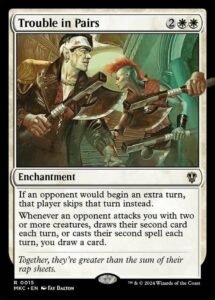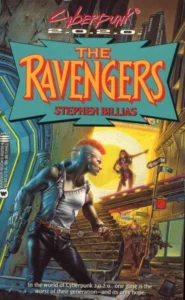Yet Another Magic: The Gathering Plagiarism Scandal

In a story that will probably be far too familiar for those who regularly read this site, fans of the Magic: The Gathering (MtG) card game have once again identified an instance of plagiarism in a new card being offered for sale.
Originally spitted in a Reddit thread by u/hypnotichog, the card, entitled Trouble in Pairs, was created by artist Fay Dalton. However, it was noticed that one of the two characters on the card was largely traced from a 1995 work created by artist Donato Giancola, who also does a lot of work for MtG, having previously drawn hundreds of MtG cards.
Dalton’s card is part of the Murders at Karlov Manor set, which was released in February 2024. Giancola’s original artwork was published on the cover of The Ravengers, a licensed novel based on the Cyberpunk 2020 universe. Ironically, Giancola also created a card for the Murders at Karlov Manor, a card entitled Caught Red-Handed.
However, the copying of Giancola’s card was not the only issue that fans spotted with the card.
According to Josh Nelson at Commander’s Herald, the free hand of the other character was traced from a 1987 painting by Boris Vallejo. Likewise, the two characters on the card are holding identical axes and are wearing identical vests, indicating that the elements were traced rather than redrawn.
As of this writing, neither Wizards of the Coast (WotC) nor Dalton have responded to the allegations. However, Giancola has responded, publishing a post on Facebook saying, “Wow. Nearly speechless, but not speechless enough not to contact a lawyer. Criminal copyright infringement.”
Unfortunately for Giancola, it is likely that he does not own the rights to the original image as it was created for Cyberpunk 2020, which is owned by R. Talsorian Games. However, as others have noted, this could theoretically create problems for WotC as it means they, hopefully unintentionally, published a card featuring artwork based on a competitor’s intellectual property.
While a lawsuit is still very unlikely, it is another major black eye for WotC, in what has been a long string of such embarrassments.
The Plagiarism and The Problem with It

The plagiarism in this story is extremely clear. Though Dalton did take steps to change the character, including altering the hair, ears and clothing, the poses are the same and it is clear from the lighting and shadows that Dalton’s work at least began with a trace of Giancola’s work.
What caught my eye the most was the background. Both works feature the character standing in front of a stairwell. However, in Dalton’s work, the stairwell behind the plagiarized character is different from the stairwell behind the other character, to the point that the steps do not line up, akin to what happens with AI art.
Nothing in this story looks good for Dalton. Not only did she copy, but she did so plainly and did so from one of the best-known and most-respected artists in the MtG universe. Such copying is always dumb, MtG fans have proven extremely vigilant about plagiarism in their art, but this case is exceptionally so because of the source that was plagiarized from.
But as bad of a look as this for Dalton, it may be far worse for WotC. As I discussed in January, 2023 was a year of scandals, backlashes, and embarrassments for the company. This included a debacle of the licensing of their rules for Dungeons & Dragons, sending literal Pinkertons to retrieve cards that were shipped too early and allegations it removed the signature of an artist when creating a film poster.
However, most relevant was a series of AI and plagiarism scandals. In August 2023, allegations were made that the company used AI for artwork in a Dungeons & Dragons sourcebook. That forced the company to update its guidance on AI. However, that did not prevent a MtG marketing image from being published despite the clear use of AI in January 2024.
In November 2023, long-time MtG artist David Sondered was accused of plagiarizing one of his cards from a work of fan art. Sondered’s story was quickly compared to an April 2021 story involving another prominent MtG artist, Jason Felix, who was similarly accused of copying from a fan creation.
In both cases, WotC cut ties with the artists involved.
However, this case makes it clear that the problem with plagiarism at WoTC is not getting better. If anything, it is getting worse.
With the earlier cases, there can be some leeway as the art was plagiarized from relatively unknown sources and it is arguable that, even with proper vetting processes, they could have been difficult to spot.
That is not true with this case.
The work was plagiarized from not just another MtG artist, but one of the best known who has been creating work for decades, including work for the same set. Furthermore, the work involved has been in publication for nearly 30 years and, while not the best-known work for the franchise, is part of the universe of a popular competitor.
But, even if they could not detect the plagiarism, the other issues with the image should have been a dead giveaway. The copied vests/axes and the mismatched stairwell should have prompted a review under the AI guidelines if nothing else. It is clear that whatever review process they have is not working.
Fixing the Problem
WotC has had multiple opportunities to fix this issue, going back to at least 2021. This is an issue that they have been aware of, they have the resources and expertise to address and the failure to do so can only be attributed to a lack of prioritizing the issue.
While no system can catch every case of plagiarism, especially when dealing with images, there were multiple opportunities to catch or at least flag this case. A close examination of this artwork should have flagged something as problematic, even if it was just the issues within the image itself.
What has become painfully clear is that WotC has done an excellent job at drafting policies that take a strong stance on plagiarism, AI, and other artist integrity issues. However, it is woefully bad at crafting systems to enforce that policy and prevent such work from making it to print.
Instead, it seems that WotC has largely taken a reactionary stance. They are crafting policies and enforcing those policies after issues are discovered, usually by their own fans. That represents a tremendous problem.
First, it is disastrous to the artists involved. Sondered and Felix (as well as likely Dalton) have had their careers effectively ruined by these allegations. While that may be fair and appropriate, it was avoidable. If these mistakes had been caught before publication, they would have had a chance to fix the issues and to learn from their mistakes, either with WotC or elsewhere.
More importantly, these scandals also harm WotC. Though not nearly as disastrous for them, these scandals chip away at their reputation and, as the numbers pile up, begin to do actual harm.
However, WotC, for whatever reason, has decided that the harm being done does not justify implementing the systems that are necessary to prevent or reduce it.
Until that changes, it is likely that these scandals will continue, likely with increasing frequency and severity as the tools for detection expand alongside the tools for copying.
Bottom Line
To be clear, WotC is not alone here. I can say almost the same thing about any publisher, regardless of medium or industry. This is not significantly different from issues traditional book publishers, news organizations and other organizations face.
However, WotC does have one unique difference: Its fan base.
Repeatedly, we have seen how the fan base of WotC products, both Dungeons and Dragons and Magic: The Gathering, are deeply passionate about the artwork and the artists that are featured. They both deeply love the creativity and beauty on display and deeply despise plagiarism.
Where readers of a news publication might barely notice a plagiarizing reporter, every plagiarism scandal, at least briefly, becomes the talk of the respective communities for WotC products.
To my mind, this unique situation calls for unique precautions. However, that is not something that WotC seems to be willing to take. Unfortunately, without change these stories are likely to continue, especially as AI becomes a growing challenge for artist communities.
Header Comparison Image: Originally created by Josh Nelson at Commander’s Herald
Want to Reuse or Republish this Content?
If you want to feature this article in your site, classroom or elsewhere, just let us know! We usually grant permission within 24 hours.
